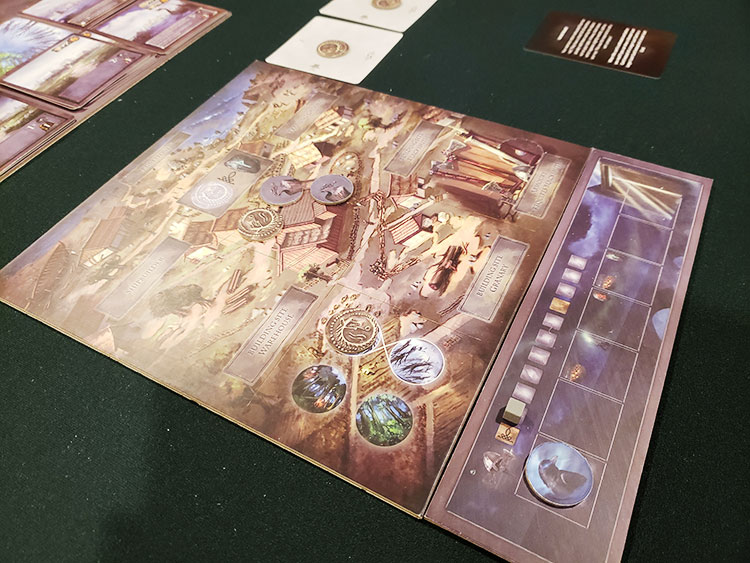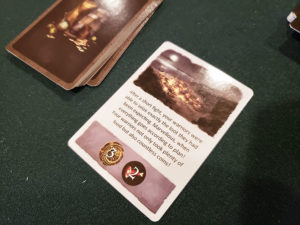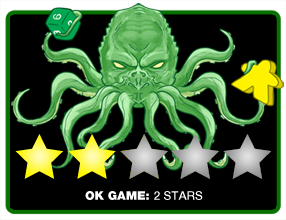 Ok, let’s get some things out of the way before this review gets into the meat. There’s a concept in this Viking-themed game called the Vikingfahrt. Yes. Read it aloud if necessary.
Ok, let’s get some things out of the way before this review gets into the meat. There’s a concept in this Viking-themed game called the Vikingfahrt. Yes. Read it aloud if necessary.
What do Vikings do after dinner? They go Vikingfahrt of course.
Why do Viking towns smell so bad? It’s all the Vikingfahrts of course.
Are we all giggled out? Good.
The Vikingfahrt is a trip to the mainland where the Viking warriors went looking for villages to plunder. In this game, it’s the crux of a mechanism whereby players gain spoils and the “Favor of the Gods”. The player with the most successful Vikingfahrts (I’m afraid it’s unavoidable) wins the game.
For our more refined and cultured readers, the game is called Valhal. It’s an action and resource management game with a Norse theme for 2 to 4 players. It takes about 30 minutes per (maturity optional) player.
Gameplay Overview:
A game of Valhal proceeds round by round through three stages, where each stage represents a season of the year. With winter and spring, players are planning their voyages and constructing buildings to help them train warriors faster and build new ships. During the summer, in addition to normal activities, the Vikingfahrt occurs and players roll dice to see what spoils and glory their adventures have yielded.

During each stage, players will decide whether to begin construction on one of the following buildings: warehouse, blacksmith, granary, and armory. Players can also upgrade their runestone “building” into a sacrificial altar. This is done by taking the appropriate tiles and placing them face-down on top of the required location on a player’s board. A coin is required every season to keep the building progressing, and every season the tile is rotated towards completion until a certain number of seasons have passed. In addition, players will need to provide a food token or a coin token for the village so that the villagers will be fed for the season (two coins in winter).
Each building mentioned above gives a specific upgrade in terms of time, the storage of, or gaining of resources. For example, the granary protects from negative effects to food supply and also allows the storage of food. The sacrificial altar opens up a larger variety of sacrifices to the gods that reward players with “Benevolence of the Gods” cards or, on the other hand, hamper other players with “Wrath of the Gods” cards.

During each Vikingfahrt, players decide in turn order which settlements they will attack and with which warriors. Players will also need the appropriate number of ships. They can even, if they wish, team up to attack settlements and distribute the spoils afterwards. Dice are rolled for each warrior card and then a separate player rolls dice for the settlements defense, both adding bonuses based on skill or settlement size respectively. The side with the lower result takes damage equal to the difference between the dice totals. Combat continues this way until one side eliminates the other or the Vikings retreat.
If a settlement is defeated, the player draws loot cards based on the settlement size. Some of these include Favor of the Gods points. In addition, these points can be gained from Benevolence of the Gods cards, acquiring achievements from reaching certain thresholds, or various event cards that are drawn before each summer stage.
The procession through seasons continues until one player has reached the end of their Favor of the Gods track. That player, being the most favorable in the gods eyes, wins the game.

Game Experience:
Before a single round was even finished during our testing, one sentiment came up for players: this game feels like multiplayer solitaire Clash of Clans without the fun of attacking each other. The object of aggression, the settlements, are a banal foil to prop up against the unimaginative Viking troops that are painstakingly trained. They’re flung against nameless civilizations with procedural dice rolls. In short, this game is far from exciting. What could be a fairly exciting theme in other games is boiled down to the minimalist of management systems requiring at most the perfect skill in dice rolling.

This comes to the second point. While the dice to be rolled are 3 sided dice (cubes with 1,1,2,2,3,3 for sides), it doesn’t escape the fact that randomness can rule the day. The laborious efforts just to get through various seasons isn’t really rewarded with engaging choices in battle. There is a simple binary decision: attack or withdraw.
Finally, and with some annoyance, the rules really could use the touch of a professional rules writer. They’re written in such a way as to tell a story without the real legalistic precision that is necessary at times in rules documents. The rules feel more like a gray tutorial than an exacting explanation of mechanisms. After having some issues, the provided online videos were welcome to understand further how to play.
Final Thoughts:
Valhal, while it might be a promised destination for brave Vikings who have given their all in battle, is not present in this game. Battle and struggle are reduced to boring mechanisms with unimaginative player choices. The art is evocative and thematic, but it covers a game that is not worthy of it. There’s nothing broken or unplayable, but what is presented is just not anything engaging, different, or exciting when compared to other titles.
Final Score: 2 Stars – If your Viking games are raising your blood pressure too much, try Valhal instead.
Misses:
• Boring
• Underdeveloped rules
• Feels very mechanical with unimaginative decisions.
























I got burned by a bogus broker recently it was hard to get a withdrawal after many failed attempts. I had to hire a refund solution firm to get my funds back.